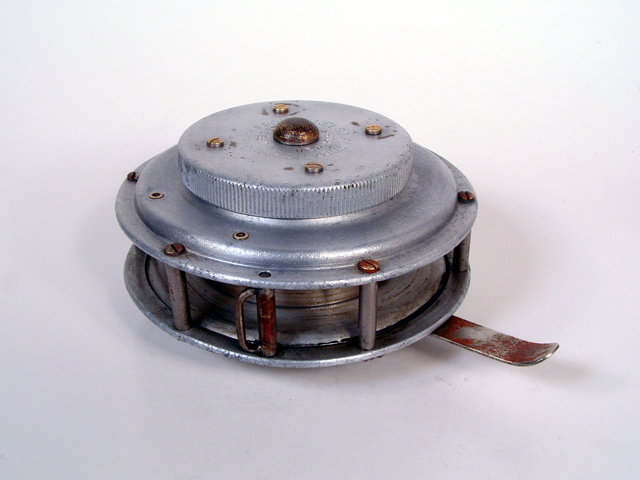Glossary of Reel Collectors' Jargon
This page includes some of the
terms you'll encounter if you're unlucky enough to be trapped on an elevator full of reel
collectors. If you have questions about other terms, feel free to e-mail me.
(Click on a thumbnail for a larger view.)
Automatic reel
A reel designed to wind in line automatically, either when the angler moves a lever or
when a fish is hooked.

Ball-handle reel
A reel with a spherical counterweight on its counterbalanced crank. These cranks usually
are found on "New York-style" reels. Believed to have been invented by John
Conroy during the 1830s, they were used for the next 60 years or so by many manufacturers.

Big-game reel
Any relatively large reel designed for salt-water trolling.

Cage reel
Usually an older, light-weight reel with a spool made of wire. The spool often is
donut-shaped. The term also is applied to reels whose sideplates and spools have large
cutouts that help ventilate the line. See "skeleton spool."
Freespool clutch
A mechanism that interrupts the drive train between the crank and the spool of a
multiplying reel, thus allowing the spool to rotate with as little hindrance as possible.
Reelmakers have been equipping their products with an amazing variety of clutches, both
manual and automatic, since 1856.
Half-crank
The term used to describe a crank, curved or straight, that extends in only one direction
from the crankshaft and, therefore, lacks a counterbalance.

Indiana-style reel
A single-action, large-diameter, narrow reel with forked "spokes," around the
ends of which the line was wound. The earliest examples patented in the U.S. were made in
Indiana. The makers believed that the large diameter permitted rapid line retrieval
without multiplying gears and that the narrow spools facilitated thumbing during the cast.

Kentucky reel
Usually a casting reel hand-made by one of about two-dozen makers in Kentucky known for
the quality of their reels. Many collectors specialize in these reels, which are
considered among the finest ever constructed. The reels were made from about 1815 to 1940,
and the styles included fly reels and salt-water reels by the end of the 19th century.

Multiplying reel
Any reel with a gear train that causes the spool to rotate faster than the crank. It is
believed that the first multipliers were made in Great Britain, probably after 1750.
New York-style reel
An older, heavy, relatively simple multiplying reel characterized by its use of a
counterbalanced crank and, sometimes, swivelling disks protecting the spool bearings. The
disks facilitated oiling. The style seems to have originated with manufacturers in the New
York City area. Some collectors reserve the term for reels with "S"- or
"reverse S"-shaped cranks, but others use it more generally to include
"ball-handle" reels and even single-action reels with qualifying cranks.

Parts terminology
This photograph shows the terminology used for
the major parts of fishing reels.
Raised-pillar reel
A reel with peripheral "ears" or extensions on its sideplates, to which the
frame pillars are attached. The design permits more line to be wound on the spool than
circular plates of the same diameter would allow. Huge numbers of reels with raised
pillars were manufactured between approximately 1870 and 1930, in a wide range of styles
and quality.

Side-mounted reel
A reel with its foot on the "side" of the reel frame. Though most reels
are mounted upright, many old single-action and automatic reels were side-mounted. Jim Schottenham's website is packed with photos of classic side-mounted reels and histories of their makers.

Single-action reel
Any reel whose spool rotates at the same speed as the crank, as its speed is not
multiplied by gears.
Skeleton spool
A light-weight spool made of wire or highly perforated sheet material (metal or rubber).
These spools usually were used in "cage reels."

Spinning reel
A casting reel whose spool does not rotate during casting because its axis is parallel to
the rod. Also called "fixed-spool" reel. It may surprise many novice collectors
to learn that spinning reels have been in use for more than a century.
|








